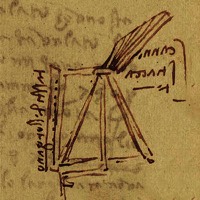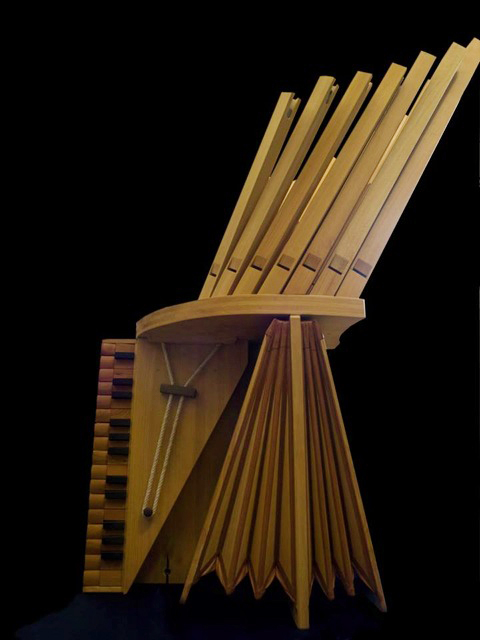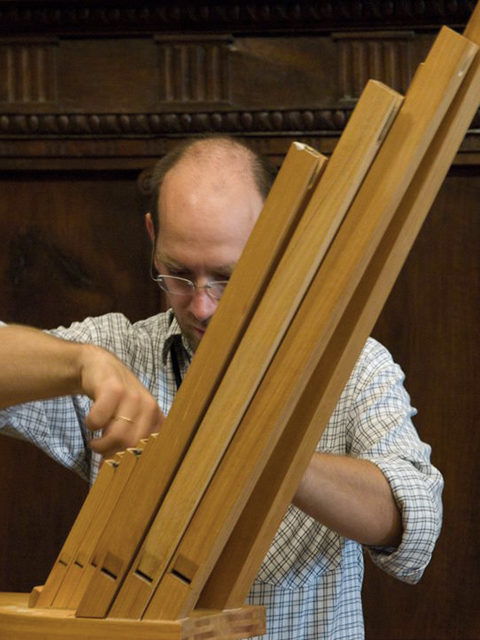Leonardo da Vinci's organ
Source: Leonardo da Vinci's Madrid Codices I + II, fl. 76

The Madrid Codices I+II are two manuscripts by Leonardo da Vinci, discovered in Madrid in 1964, showing the sketch of a portable organ which may be considered revolutionary if compared to normal medieval organetti.
To our knowledge, it was the first time Leonardo designed a “double action bellows” to create the so-called “ventum continuum”: He introduced an upright keyboard (similar to the modern accordion). Also, he annotated “canne di legno o di carta” (paper o wooden pipes), typically used for small Renaissance chamber or chapel organs.
After over eight years of intense studies of iconographies, repertoire, building and playing techniques, Walter Chinaglia and the internationally recognised organetto player Guillermo Pérez succeeded in developing a perfect interpretation of Leonardo's portable organ, taking into account all elements mentioned above. Moreover, they found a plausible explanation of the uncommon arrangement of pipes, that offers a solution to fit many pipes into a small space.
Guillermo performed with Leonardo’s organetto at some of the most prestigious European festivals and venues:
To our knowledge, it was the first time Leonardo designed a “double action bellows” to create the so-called “ventum continuum”: He introduced an upright keyboard (similar to the modern accordion). Also, he annotated “canne di legno o di carta” (paper o wooden pipes), typically used for small Renaissance chamber or chapel organs.
After over eight years of intense studies of iconographies, repertoire, building and playing techniques, Walter Chinaglia and the internationally recognised organetto player Guillermo Pérez succeeded in developing a perfect interpretation of Leonardo's portable organ, taking into account all elements mentioned above. Moreover, they found a plausible explanation of the uncommon arrangement of pipes, that offers a solution to fit many pipes into a small space.
Guillermo performed with Leonardo’s organetto at some of the most prestigious European festivals and venues:
- Delft - Utrecht Early Music Season (Netherlands) 6.02.13
- Ammerzoden - Utrecht Early Music Season (Netherlands) 7.02.13
- Utrecht - Utrecht Early Music Season (Netherlands) 8.02.13
- Amsterdam - Utrecht Early Music Season (Netherlands) 9.02.13
- Amerongen - Utrecht Early Music Season (Netherlands) 10.02.13
- Moscow - Festival La Renaissance (Russia) 30.06.13
- Köln - WDR (Germany) 19.04.13
Moro de doglia - Aymè, sospiri (Anon. Petrucci, Frottole)
“Da Vinci Project" Live recording, concert in Köln - WDR Early Music Series
Guillermo Pérez, organetto da Vinci
Angélique Mauillon, harp
Viva Biancaluna Biffi, fiddle
“Da Vinci Project" Live recording, concert in Köln - WDR Early Music Series
Guillermo Pérez, organetto da Vinci
Angélique Mauillon, harp
Viva Biancaluna Biffi, fiddle
Conference at l'Accademia di Brera. "Leonardo, la musica, la scena" , November 2019


